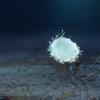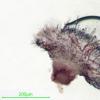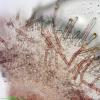
18-12-2025 17:23
 Bruno Coué
Bruno Coué
Bonjour,je serais heureux d'avoir votre avis sur c

18-12-2025 21:17
Pol DebaenstThe identification took me to Byssonectria deformi

18-12-2025 18:07
Margot en Geert VullingsThese plumes were found on rotten wood.They strong

17-12-2025 18:35
 Michel Hairaud
Michel Hairaud
Bonjour à tous/Hi to everyone I am passing along

15-12-2025 15:48
 Danny Newman
Danny Newman
Melanospora cf. lagenaria on old, rotting, fallen

15-12-2025 15:54
 Johan Boonefaes
Johan Boonefaes
Unknown anamorph found on the ground in coastal sa

15-12-2025 21:11
 Hardware Tony
Hardware Tony
Small clavate hairs, negative croziers and IKI bb

15-12-2025 07:09
 Danny Newman
Danny Newman
indet. Rutstroemiaceae sp. on unk. fallen leavesMc
The apo is short stipitate with scattered marginal hairs 54-76 × 6,0-8,2 µm, walls on avg. 0,7 µm thick, ±capitate. Asci probably without croziers, 39-45 × 3.0-3.7 µm, IKI bb, 8-spored. Ascospores (6.5) 6.7-8.9 (10.4) × (1.5) 1.6-1.97 (2.0) µm, oil 0. Paraphyses lanceolate, 62-70 × 3.4-3.5 µm.
In the litteratre I have found two (potentially synonymous) taxa on Carex. Karsten's Trichopezizella nidulus var. hystricula was also on C. acuta collected not far away. Hains (1974) gives the spore size as (9-)10-14(-15) X 2-3 µm and hairs to 130 µm.
Trichopezizella badiella, likwise Karsten's, was collected on Bolboschoenus maritimus. Both original collections were immature but the name has, nevertheless, been used later for a species with spores 8-10x2 µm and hairs to 130x6 µm, also on Carex.
My fungus has somewhat smaller spores and shorter hairs. I am a bit confused - what should I call this fungus, T. cf. badiella perhaps? Any experience of this complex, someone?






